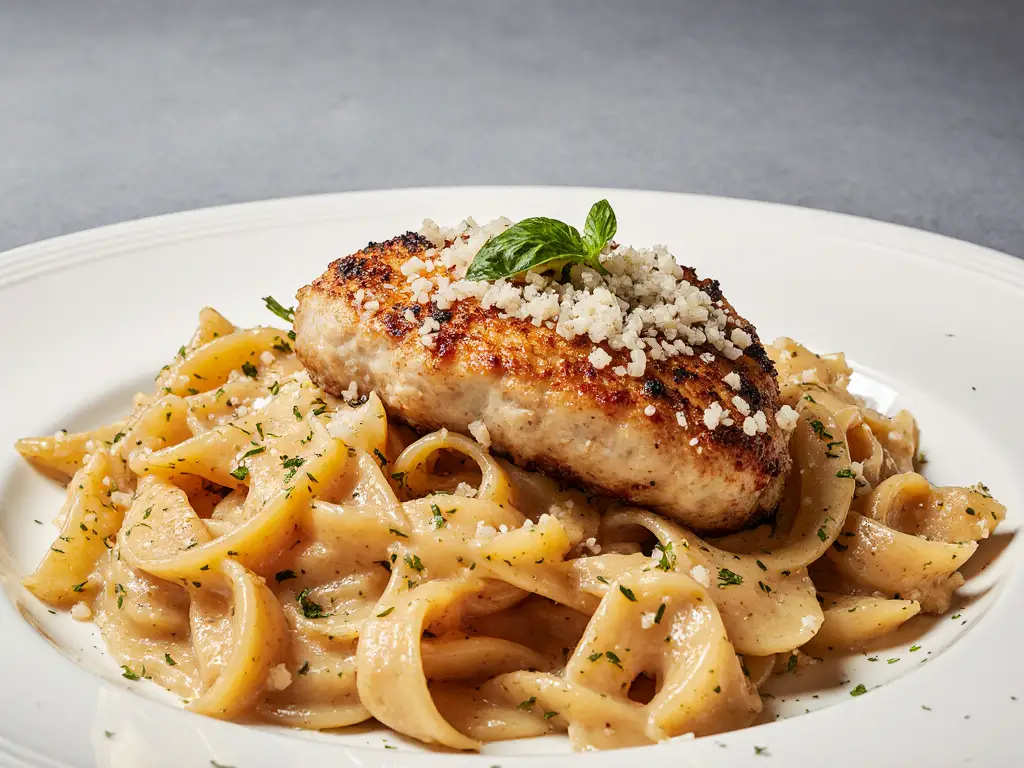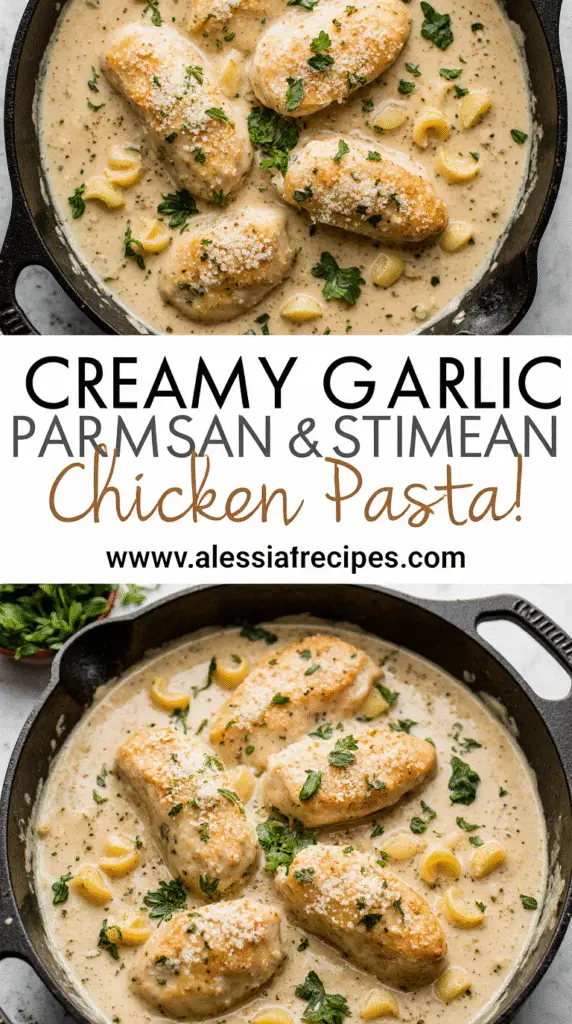How to Make Creamy Chicken Parmesan Pasta: 30-Minute Family Favorite
Craving creamy chicken parmesan pasta that tastes restaurant-worthy but takes just 30 minutes to make? You’re in luck! This ultimate comfort food dinner comes together in a single pan, making it perfect for those busy weeknights when you need something delicious and satisfying.
Not only is this garlic parmesan chicken pasta rich and cozy with flavor in every bite, but it also requires minimal pantry staples. Whether you’re feeding a hungry family or looking for an impressive yet simple meal, this creamy garlic parmesan chicken pasta delivers with its tender chicken pieces and pasta that holds onto every bit of that luxurious sauce. When the comfort food craving hits, this chicken parmesan pasta recipe is exactly what you need—satisfying, flavorful, and best of all, ready in about half an hour[-4].
In this guide, we’ll walk you through creating this family favorite step by step, sharing all our tips for perfect texture and flavor along the way.
Essential Ingredients for Creamy Chicken Parmesan Pasta
Getting the right ingredients is crucial for making an outstanding creamy chicken parmesan pasta. The quality and preparation of each component will significantly impact your final dish, so let’s explore what makes this recipe shine.
Chicken: Best cuts and prep tips
For truly delicious creamy chicken parmesan pasta, choose between chicken breasts or thighs. Chicken tenderloins or boneless skinless thighs are particularly excellent choices since they remain juicy and tender throughout cooking due to their higher fat content. Moreover, they absorb all the garlicky, cheesy flavors wonderfully.
If using chicken breasts, flatten them to an even thickness (about half-inch) with a rolling pin. This simple technique ensures they cook evenly and quickly without drying out. Subsequently, cutting the chicken into bite-sized pieces allows it to cook perfectly and distributes the meat evenly throughout your pasta dish.
Pasta: Choosing the right shape
The pasta shape you select dramatically affects how well your dish holds its creamy sauce. Shapes with ridges, curves, or pockets will grab onto thick sauces so you don’t end up with flavor left at the bottom of your bowl.
Five pasta shapes that pair perfectly with creamy sauces include:
- Fettuccine: Classic choice for creamy sauces with flat, wide noodles that provide enough surface area for sauce to coat evenly
- Penne: Features ridges and a hollow center that captures thick sauces brilliantly
- Rigatoni: Essentially penne’s bigger cousin with wide tubes and deep ridges, perfect for baked creamy dishes
- Farfalle (bowties): The pinched center gives a nice chewy bite while the wings scoop up creamy sauces
- Shells: Their cup shape naturally holds sauce
Garlic and Parmesan: Flavor foundations
Fresh garlic cloves provide an irreplaceable aromatic base for your creamy chicken parmesan pasta. Meanwhile, Parmesan cheese serves as both a thickening agent and flavor enhancer.
Always opt for freshly grated Parmesan cheese rather than pre-grated varieties. Pre-grated cheese often contains additives and won’t melt properly into your sauce. Additionally, high-quality Parmesan like Parmigiano Reggiano offers superior flavor that transforms the entire dish.
Cream and Broth: Building the sauce base
The foundation of your creamy sauce comes from the perfect combination of cream and chicken broth. These two ingredients, when simmered together, create a rich, velvety texture.
Heavy cream provides richness, though some chefs prefer single or light cream as it thickens naturally during cooking. Furthermore, warming the cream before adding it to the pan prevents curdling and ensures smooth incorporation.
Chicken broth adds depth and savory notes while helping to thin the sauce to the perfect consistency. Additionally, combining these ingredients with butter creates that silky texture that makes this pasta dish irresistible.
Step-by-Step Cooking Instructions
The magic of creamy chicken parmesan pasta happens in the cooking process. Follow these simple steps to transform basic ingredients into a restaurant-quality meal right in your kitchen.
1. Season and sear the chicken
First, pat your chicken pieces dry with paper towels to remove excess moisture. Season generously with salt, pepper, Italian seasoning, garlic powder, and a touch of paprika. For even cooking, pound chicken breasts to an even half-inch thickness. Heat a large skillet over medium-high heat with a drizzle of olive oil. Once hot, add the seasoned chicken and sear for about 5-6 minutes, turning once, until golden brown on the outside yet still slightly pink inside. Remove chicken to a plate and set aside.
2. Sauté garlic and onions
In the same pan with those flavorful browned bits, add a tablespoon of butter. Once melted, add diced onions and cook for 2-3 minutes until they begin to soften and turn translucent. As soon as the onions have softened, add minced garlic and continue cooking for another 30-60 seconds until fragrant. Be careful not to burn the garlic as it will quickly become bitter.
3. Deglaze and simmer the sauce
Now comes the flavor-building step! Pour in about a cup of liquid (chicken broth, wine, or even pasta water) into the hot pan. Immediately use a wooden spoon to scrape up all those caramelized bits from the bottom—they contain immense flavor. Bring to a simmer, then stir in marinara sauce or cream, depending on your preference. Allow the sauce to reduce slightly, simmering for 5-10 minutes until it begins to thicken.
4. Cook pasta and combine
Meanwhile, cook your pasta in salted water until just shy of al dente (about 2 minutes less than package instructions). Reserve a cup of starchy pasta water before draining. Add the pasta directly to the sauce, along with a splash of pasta water. Toss everything together, allowing the pasta to finish cooking in the sauce and absorb those flavors.
5. Add cheese and finish with parsley
Finally, return the chicken to the pan. Gradually sprinkle in freshly grated Parmesan cheese while stirring continuously to create a smooth, velvety texture. Top with mozzarella if desired, cover briefly until melted. Garnish with freshly chopped parsley for a pop of color and fresh flavor before serving your delicious garlic parmesan chicken pasta.
Tips for Perfect Texture and Flavor
Perfect execution requires attention to detail when making creamy chicken parmesan pasta. These professional tips will elevate your dish from good to extraordinary.
Use freshly grated parmesan
Boxed pre-grated parmesan simply won’t deliver the same results. Indeed, freshly grated parmesan melts better, creating a smoother sauce without clumping. Pre-grated varieties often contain additives that prevent proper melting and compromise flavor. Grate your parmesan just before adding it to the sauce for maximum impact.
Avoid curdling the cream
Curdling occurs when proteins in dairy bind together and separate from water. To prevent this, never let your cream-based sauce boil. Instead, add dairy gradually at the end of cooking. Obviously, higher-fat products like heavy cream are less prone to curdling than milk. Furthermore, adding a starchy thickener like flour or cornstarch helps stabilize the sauce.
How to tell when chicken is done
The most accurate method is using a thermometer – chicken breasts should reach 165°F (73°C) and dark meat 175°F (79°C). Alternatively, make a small incision in the thickest part; the meat should appear white/opaque without pinkness. Clear (not pink) juices indicate doneness. Allow chicken to rest 5 minutes before slicing to lock in juices.
Balancing salt and seasoning
Salt pasta water generously – it should taste like seawater. However, wait until the end to season your sauce, especially with dairy-based recipes, as salt can sometimes trigger curdling. Taste throughout cooking, adjusting gradually.
Customizations and Dietary Swaps
The beauty of creamy chicken parmesan pasta lies in its versatility. With a few thoughtful swaps, this family favorite can accommodate various dietary needs without sacrificing flavor.
Make it gluten-free
Transforming this dish into a gluten-free delight is straightforward. Simply substitute your regular pasta with gluten-free varieties—brown rice pasta works exceptionally well as it holds its shape and doesn’t get soggy when baked. Brands like Jovial, Tinkyada, and Trader Joe’s offer excellent brown rice pasta options. For breadcrumbs, use gluten-free panko or crushed gluten-free crackers to maintain that classic crispy texture. Alternatively, almond flour can serve as a more paleo-friendly coating option.
Dairy-free alternatives
Creating dairy-free creamy chicken parmesan pasta is entirely possible with plant-based substitutions. Replace parmesan with nutritional yeast and use dairy-free mozzarella shreds. For the cream sauce, consider these alternatives:
- Cashew cream: Soak raw cashews in hot water for 10-15 minutes, then blend with water
- Coconut milk: Full-fat coconut milk provides richness and creaminess
- Plant-based yogurt: Unsweetened dairy-free yogurt thickens sauces beautifully
Add-ins: spinach, mushrooms, or bacon
Customize your chicken parmesan pasta by incorporating vegetables. Spinach, zucchini, and onions blend seamlessly—simply add them when cooking the chicken. Cremini mushrooms add earthy depth; sauté them for three minutes on each side before adding bell peppers and green onions. Adding vegetables not only enhances flavor but also boosts nutritional value.
Spice it up with red pepper flakes
Craving heat? Add red pepper flakes to your creamy chicken parmesan pasta for a pleasant kick. Actually, you can control the spice level—use more flakes for extra heat or incorporate hot oil with red peppers for a different dimension of spiciness. Conversely, if making for those with milder preferences, use regular marinara and reduce the red pepper flakes.
Conclusion
This creamy chicken parmesan pasta truly stands as the ultimate weeknight dinner solution for busy families. Throughout this guide, we’ve explored everything from selecting the perfect chicken cuts to choosing ideal pasta shapes that capture every drop of that luxurious sauce. The beauty of this dish lies not only in its simplicity but also in its incredible adaptability.
Your family will undoubtedly appreciate how this meal delivers restaurant-quality flavor without the lengthy preparation time. After all, the entire dish comes together in just 30 minutes while dirty dishes remain minimal thanks to the one-pan approach. The combination of tender chicken, perfectly cooked pasta, and velvety garlic-parmesan sauce creates a comfort food experience that satisfies deep cravings.
Remember that small techniques make significant differences – freshly grated parmesan, properly seared chicken, and gentle treatment of cream transform ordinary ingredients into something special. Additionally, the customization options we’ve discussed allow this recipe to work for nearly any dietary need without sacrificing the rich, comforting essence that makes it so beloved.
Whether you stick with the classic version or experiment with gluten-free pasta, dairy alternatives, or vegetable additions, this chicken parmesan pasta promises to become a regular request at your dinner table. Next time comfort food cravings strike or you need a quick yet impressive meal, this recipe awaits – ready to deliver warmth, flavor, and satisfaction with minimal effort.
FAQs
Q1. How long does it take to make Creamy Chicken Parmesan Pasta? This delicious meal can be prepared in just 30 minutes, making it an ideal choice for busy weeknights when you need a quick yet satisfying dinner.
Q2. What’s the best type of pasta to use for this dish? Pasta shapes with ridges, curves, or pockets work best as they hold onto the creamy sauce well. Good options include fettuccine, penne, rigatoni, farfalle, or shells.
Q3. Can I make this dish gluten-free? Yes, you can easily make it gluten-free by using gluten-free pasta varieties, such as brown rice pasta, and substituting regular breadcrumbs with gluten-free alternatives or almond flour.
Q4. How can I prevent the cream sauce from curdling? To avoid curdling, never let your cream-based sauce boil. Add dairy gradually at the end of cooking, and consider using higher-fat products like heavy cream, which are less prone to curdling.
Q5. What are some ways to customize this recipe? You can customize the dish by adding vegetables like spinach, mushrooms, or zucchini, adjusting the spice level with red pepper flakes, or making it dairy-free using plant-based alternatives like cashew cream or coconut milk.


